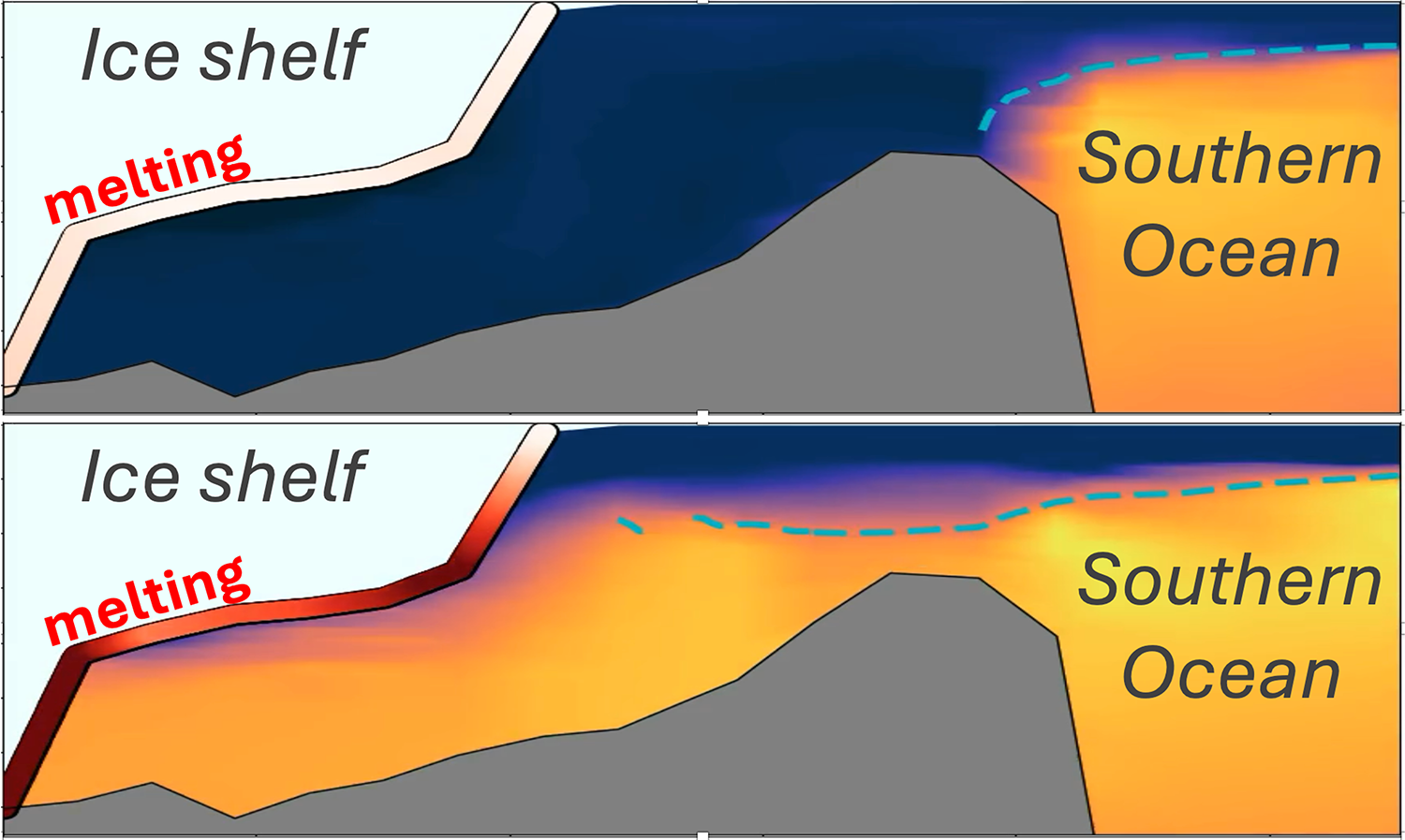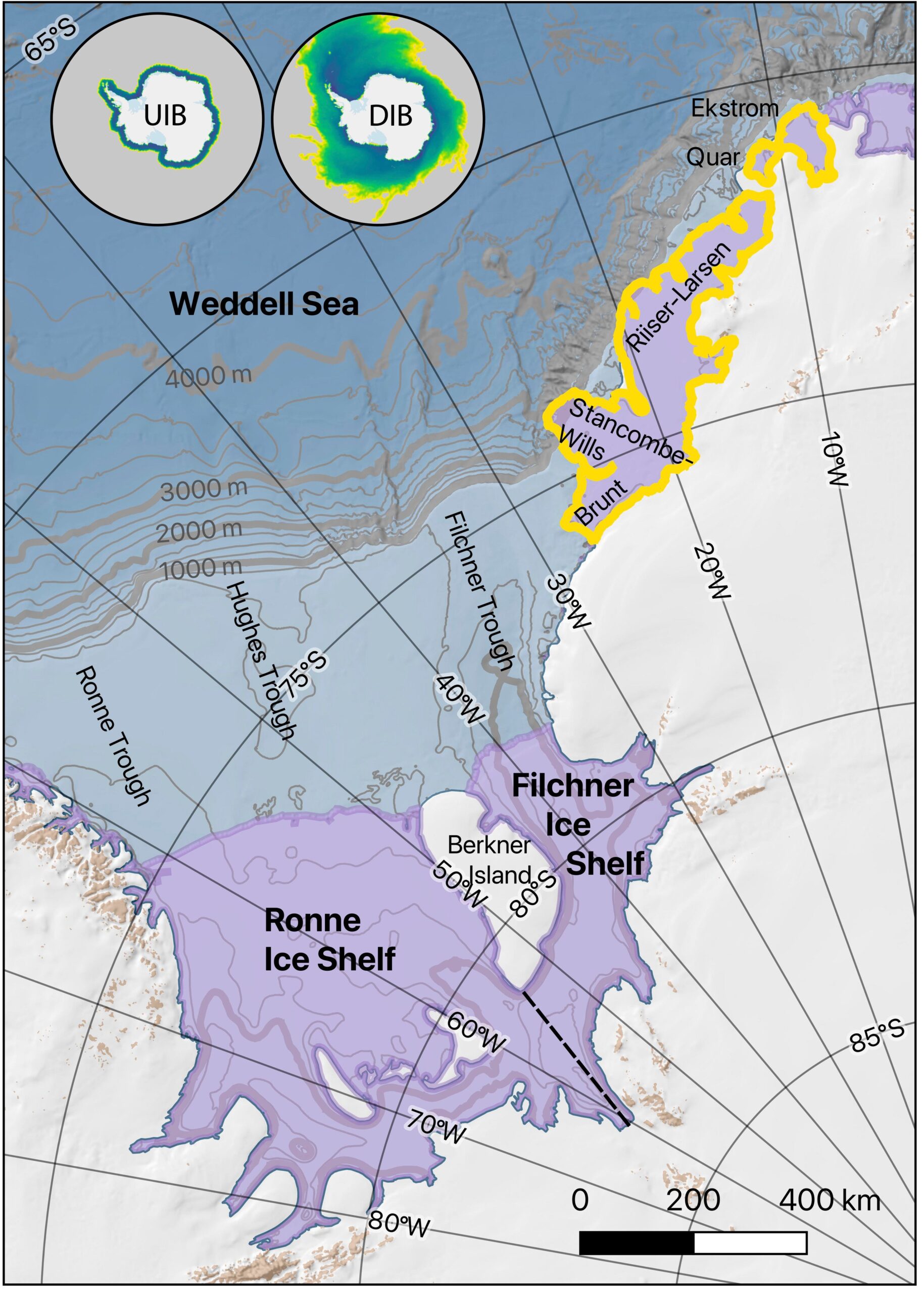Meltwater Triggers for an Antarctic Ice-Shelf Melt Tipping Point

Figure 1. Simulation of warm water intrusion into cavity beneath Filchner-Ronne Ice Shelf. As near-shore density blockage (turquoise dashed line) becomes shallower, ice-shelf basal melt rates subsequently increase by an order of magnitude (represented by the red color along the ice-shelf base). Color represents water temperature from deep navy for cold water to orange for warm.
Meltwater from icebergs and ice shelves around Antarctica may facilitate the intrusion of warm, deep, offshore water, leading to an ice-shelf melt tipping point.
The Science
In climate science, a tipping point is a critical threshold in the Earth’s system that can cause sudden, significant, and often irreversible changes if crossed. The second largest ice shelf in Antarctica may be susceptible to such a tipping point leading to a manyfold increase in melting from the ocean if warm, deep, offshore ocean water gains access to the floating ice-shelf base (Fig. 1). Using a series of experiments with the Energy Exascale Earth System Model (E3SM), researchers demonstrate that changes in meltwater from icebergs or nearby ice shelves may be sufficient to trigger this tipping point.

Figure 2. Map of the southern Weddell Sea and Filchner–Ronne Ice Shelf. The dotted black line indicates the boundary between Filchner and Ronne ice shelves used in this study. The yellow outline indicates eastern Weddell Sea ice shelves under which prescribed melt rates are applied. Inset maps show the relative distribution of iceberg melt flux on a log scale for the uniform iceberg (UIB) and data iceberg (DIB) configurations. Gray lines are bathymetry contours (Dorschel et al., 2022). The base map is from Quantartica (Matsuoka et al., 2018).
The Impact
The results show that simulating ice-shelf basal melting realistically in global Earth system models requires careful treatment of Antarctic meltwater and ocean processes that is missing in low resolution ocean models. Earth system model projections of the future of the Antarctic Ice Sheet need to demonstrate skill in representing present-day Southern Ocean density structure to be credible.
Summary
The Filchner-Ronne Ice Shelf (FRIS), the second largest ice shelf in Antarctica (Fig. 2), is believed to be susceptible to a tipping point from a low to high ice-shelf basal melt regime in the future. This could occur if ocean density on the continental shelf around Antarctica decreases to the point it can no longer block the intrusion of warm, deep, offshore water (Fig. 1). Version 1 of E3SM was prone to erroneously crossing the FRIS melt tipping point under preindustrial conditions due to model biases in ocean density. This work identifies controls on the FRIS instability and how they should be treated in a low-resolution global Earth system model like E3SM. The researchers compared E3SM v1.2 simulations with different treatments of factors that affect ocean density on the continental shelf. Necessary features to avoid the unrealistic density bias were a realistic spatial distribution of iceberg melt and an ocean eddy parameterization that takes into account spatial variations in ocean stratification. Additionally, they found that freshwater from melting of nearby ice shelves could potentially trigger the FRIS tipping point, suggesting a possible domino effect of increasing melt between ice shelves.
Publication
- Hoffman, Matthew J., Carolyn Branecky Begeman, Xylar S. Asay-Davis, Darin Comeau, Alice Barthel, Stephen F. Price, and Jonathan D. Wolfe. 2024. “Ice-Shelf Freshwater Triggers for the Filchner–Ronne Ice Shelf Melt Tipping Point in a Global Ocean–Sea-Ice Model.” The Cryosphere 18 (6): 2917–37. https://doi.org/10.5194/tc-18-2917-2024.
Funding
- This work was supported by the Earth System Model Development program area of the Department of Energy, Office of Science, Biological and Environmental Research program, through the E3SM project and the DOE Office of Science Early Career Research Program.
Contact
- Matt Hoffman, Los Alamos National Laboratory
This article is a part of the E3SM “Floating Points” Newsletter, to read the full Newsletter check:


